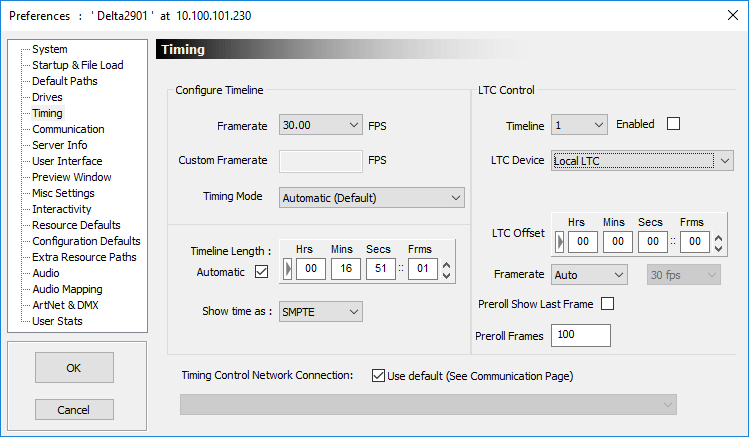Configure the timing for the frame rate you require. A faster framerate gives smoother playback, but depending on the file size of the movie you are loading, you may run out of horsepower in the PC, and the framerate will not be maintained. Note also that some movies are designed for a particular framerate – playing them faster or slower may not give the intended effect.

It is always better to choose a framerate at which the media does not drop frames (stutter), so if your movie cannot play steadily at (for example) 60 frames per second, drop it to the next lowest framerate (30 FPS). Alternatively, reduce the resolution of the media, or remove other parallel media in order to reduce the load.
Optimal framerates are displayed in the listbox, which are integer divisions of the graphics card framerate, so if set to 60 Hz, optimal rates are 60, 30, 20, 15, 7.5 etc.
You may want an optimal framerate of 50 FPS. To achieve this, set the graphics card monitor refresh rate to 50 Hz (using the normal Windows Display configuration dialog), and restart the server. This may require editing or adding EDID data to the graphics card. (See the DeltaMonitor User Guide.)
The Timeline Length determines what length of the timeline is controlled by the scrollbar in the Timing Area. Simply set this slightly larger than the show length or enable Automatic to auto-calculate this length.
Time can be shown as SMPTE (e.g. Hours, minutes, seconds and frames – 00:01:20:12) or Frames (e.g. 1200 frames). This is simply how the time is viewed on the Timing Area, and does not affect how the show is played.
Timing Mode
This should normally be in Automatic. Other timing Modes:
Use Hardware
Time from the internal hardware timer (graphics refresh rate).
Use Software
Time from a software timer
Windowed
Use this mode if timing is not constant when the playback window is non-fullscreen
Gfx Lock
Re-syncs the GPU to hardware frame boundaries when the timeline rate is a subdivision of the VSync rate, used for example for 24 fps on a 60 Hz refresh rate, will re-sync every 5th frame (since 120 is the nearest value common to both).
For Automation
Render will run at full rate independent of the timeline rate (so animations can run at 60 fps even with timeline rate set to 30 fps) – Note that there is significantly higher GPU load.
Timing Control Network Connection
Choose Use Default (which is configured on the Communication page), or untick this option, then select the network interface for timing packets in order to separate them from the other network traffic.
Timing Configuration – Genlocked / LTC Chase
➢See Synchronising Delta Media Systems for an overview of synchronisation between show media, Delta Media Servers, display and audio devices, and other elements of show control.
In a genlocked system, LTC chasing via suitable hardware is available. This allows an external LTC audio track to directly control the playback.
Note that for perfect timing when chasing LTC, the LTC timecode should be synchronous with the genlock video sync. This usually means the LTC source requires a genlock signal which is also sent to the server. Even without a genlocked LTC source, the server will still chase LTC. |
Timeline
Select this and the Enabled button to set specific timelines to chase LTC.
Enabled
This switch is replicated on DeltaGUI in the timing area, when enabled, timeline controls such as stop, play, rewind are hidden, and external control of the playback position is enabled.
SMPTE Device
When available, the list of LTC input devices available is presented: select the one which will be the LTC input master.
| Local LTC: Select if you’re receiving LTC timecode through a standard audio input on the server. You will select this in conjunction with running LTCReader or Soundman. |
| Adrielec: Select if you’re receiving LTC timecode through an Adrielec card in the server. |
| Delta : Select to choose a different Delta group to be the LTC master to this server. Note that this server will therefore play in sync with the master server from the selected Delta group. |
| Sony422 VTR BlackMagic (COMX) : Select to receive LTC from the RS422 input of a BlackMagic SDI card. |
| Sony422 VTR Bluefish : Select to receive LTC from the RS422 input of a Bluefish SDI card. |
| CSony422 VTR (com78) : Connect to a Sony protocol LTC device on com78. |
| For all options apart from Delta, there are options for Framerate: Auto, Drop or Non Drop and Drop and Non Drop can choose 60, 30, 29.97, 25 or 24 fps rates. |
SMPTE Offset
Since there is no negative time in the LTC timecode, many LTC audio tracks start at 59mins, 50 secs, which allows a 10s preroll, and the show starts at 1 hour. The LTC Offset allows you to type in 59 min, 50s, which will be subtracted from the incoming timecode which means the Delta content can start at 0 time on the timeline.
Incoming Rate
This is the LTC timecode rate read from the LTC Input Device.
Preroll Show Last Frame
During the preroll period, show the last frame rendered instead of black.
Preroll Frames
The number of frames to preroll before showing the content.